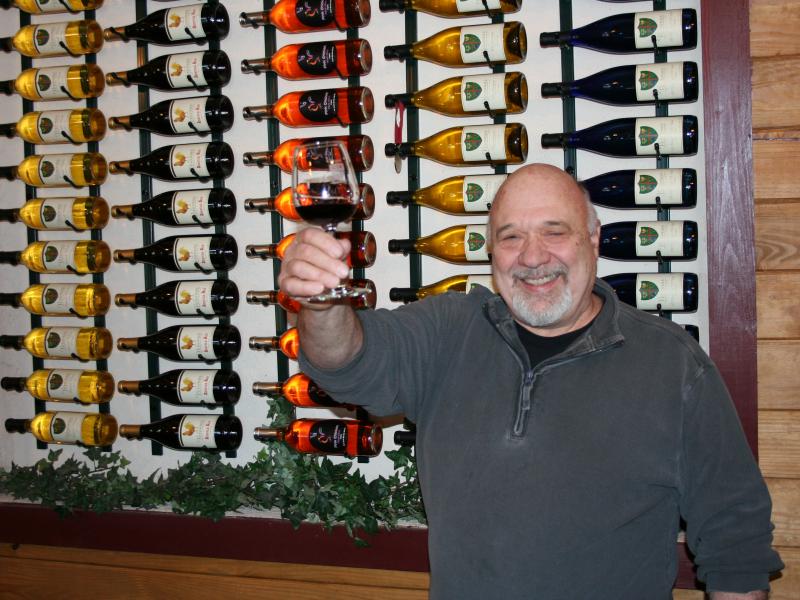Virginia is well known for its revolutionary and Civil War history. One of the original 13 colonies, it’s practically the birthplace of the U.S. It’s less known however for the 150 wineries which dot the landscape, turning out respectable wines since the days of the founding fathers.
Less than 30 minutes outside of Dulles International Airport, a dirt road winds through a heavily forested area, then breaks into the vast Shenandoah Valley. A former cow barn which has been fully restored is now the site of Veramar Winery which possesses commanding views of the valley and will command your attention as well, because of the quality of their wines. The wood paneled tasting room has a fireplace off to the side and an adjoining gift shop and art gallery. The modest room reflects the modest building which utilizes the Blue Ridge Mountains for its backdrop. But stepping back over forty years, Vera-Mar Steakhouse in North Carolina was the unwitting beginning of Veramar Vineyards.
“We didn’t have much money back then,” explains Jim Bogaty, Veramar’s owner. “My wife and I got married in the living room of friend’s house, we didn’t even have a car,” he recalls. Jim and his wife Della had their honeymoon at Vera-Mar restaurant, and enjoyed “a steak dinner for two and a bottle of wine,” which cost $23.69, “a half months pay for the military,” he adds.
Jim has the original menus and receipt framed and hung on the wall of the tasting room. Decades later, when deciding what to call their new winery, the name Veramar, meaning ‘view of the small waters,’ seemed the most logical of choices. “We started at Vera-Mar and we’ve come full circle,” Jim says. In between Jim worked for Verizon and AT&T and decided after decades of corporate work, it was time to retire.
Like many people who retire the first days and weeks seem exciting, but a lack of routine quickly sets in. “Now what do I do?” Jim asked his wife. They purchased just over 100 acres with the intention of running cattle on it, but the land was too small a parcel to make it financially viable. Jim’s father in law suggested planting grapes, since Jim had always loved wine. So Jim phoned Virginia Tech and asked if they would come out to the property and give their opinion of the wisdom of planting grapes. They in turn suggested that the limestone-based soils and the similar climate to that of the Loire Valley in France, with a river running between flanking mountain ranges would be ideal. So Jim put 11 acres under vine and sunk a well.
Since 2000, the year they opened, they are now up to a 5,000 case production, and average three tons of fruit per acre. They are planning to expand that as Veramar and other Virginia wineries attempt to make their place on the world stage. “I want to break out of the Virginia mold. Where we sit right now, we’re within a four hour drive time of 50 percent of the U.S. population. That’s the network I want to plug into,” Jim says. And currently he says that less than five percent of wines made in Virginia even leave the state. Therefore, there are a lot of people buying wine and the quality has defiantly improved.
But Jim has his eyes on an even bigger prize. “I want to get known in London. The Brits are one of the largest consumers of alcoholic beverages on the planet,” he notes. It helps that Washington D.C, is less than an hour away by car. “We get a lot if international travelers,” he says. Many European Union travelers want a “day in the country” after time in the concrete-heavy D.C. area, so the peaceful Shenandoah Valley, with its wineries, history and low rolling hills are the perfect draw.
Veramar produces chardonnay, using Virginia oak, seyval blanc (a staple of the area) and a rosé called Pink Chicken, made primarily from the tannant grape which creates a strawberry nose with an excellent balance of acidity and body. Then there is the mourvèdre a deep, spicy wine with a very long finish. “It’s like walking into a leather shop chewing on a chocolate bar,” Jim tells me. And indeed he’s not far off. But it is the merlot made from free run juice that is the most mature of his wines. Merlot gets a bad rap, but this wine is rich with cassis, black pepper and blackcurrant. Being inundated with merlots from California, it’s surprising to find a version that can stand up to West Coast versions, but Veramar’s merlot, along with other wines, will have you rethinking not only merlot, but Virginia wines in general.







